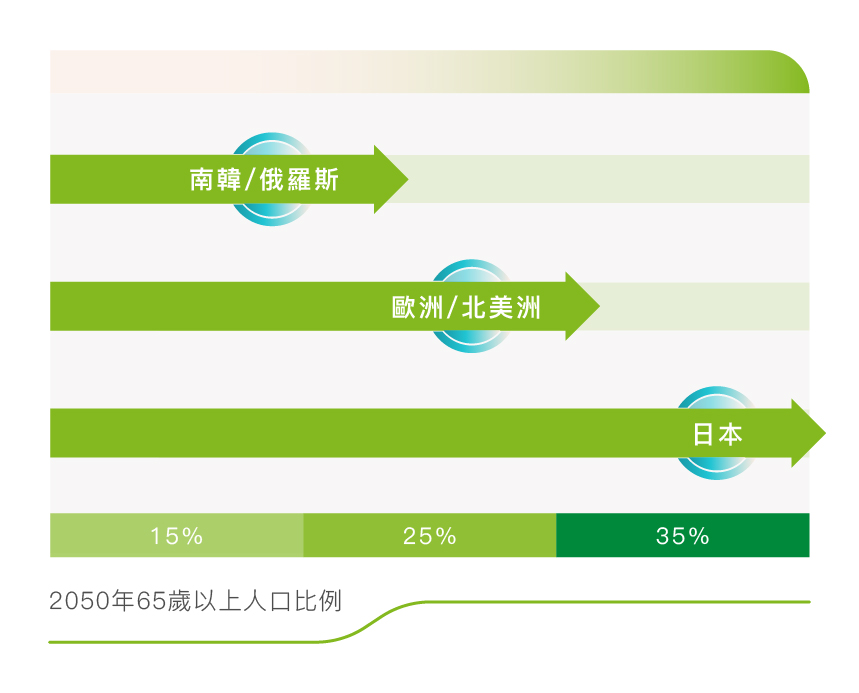THE AGING TSUNAMI IS EVERYWHERE

The Aging or getting older age phenomenon has become the most closely watched topic of global population changes in the 21st century. According to the definition of the World Health Organization (WHO), the proportion of people over 65 in the total population is 7% which is called an “aging society”, 14% is called an “aged society”, and 20% is called a “super-aged society”. With the continuous advancement of medical technology, the extension of human life span has become a universal phenomenon in the world. It also represents that in accordance with the future trend of aging. The senior wellness issues should not be underestimated.
Additionally, the extension of human life span has also produced a major change in the global population structure. In addition to the total global population will increase year by year, the proportion of the elderly population will also increase. It will cause governments around the world to have corresponding plans for the health disease care of the elderly population in various countries, and have comprehensive adjustments and changes in national policies, legal systems, physical environment and health and medical strategies. Especially the dementia and disability of the elderly, which are important issues for governments around the world.
According to the UN’s 2019 World Population Outlook report, the global population will be approximately 7.7 billion in 2019; it is estimated to increase to 8.5 billion in 2030; 9.7 billion in 2050; and 10.9 billion in 2100. In 2019, the world’s 65-year-old population was 1 in 11, approximately 9% of the global population. It is estimated that in 2050, 1 out of every 6 people in the world will be over 65, approximately 16% of the total population. From 2019 to 2050, in the area of North America, West Asia, Central Asia, South Asia, Southeast Asia, Latin America and the Caribbean, the population over 65 will double. And by 2050, in countries in Europe and North America, the population over 65 years old will reach more than 25%, which is, 1 in 4 people is 65 years old.


Aging population in Asia is particularly noticeable, especially in countries in East Asia and Northeast Asia, which have the highest rates of elderly population in the world. According to the UN’s 2015 Population Outlook Report, in 2015, people lived in China, South Korean, North Korea, Japan, Mongolia and the Russian Federation. The population over 65 in the 6 ENEA countries accounted for 32% of the world’s elderly population and 56% of all Asian countries.
The ENEA population is aging at an alarming rate. It took 150 years for the population over 65 years old in France to rise from 7% to 20%, while Japan only reached this rate after 40 years. China and South Korea are estimated to be only 35 and 30 years respectively. In addition, because China’s population is indeed very large, ENEA’s elderly population will rapidly increase to more than 300 million in 2040. Overall, the population aging and growth in ENEA countries today will be rapid and scale unprecedented in human history. Facing “aging” is unavoidable. The most important thing is to create a healthy environment suitable for life in old age and let elderly can grow old healthily. For elderly people, regular exercise can not only improve the quality of life, but also delay most of the decline and disability of body functions caused by aging. And the decline of body functions caused by aging, such as muscle strength, joint flexibility and mobility, activity function and balance performance gradually decline with age. And the above-mentioned factors will eventually affect elderly’s future daily functions.


However, as long as the elderly people can engage in regular exercise and leisure activities, those 3 accompanying unsecure issues “Healthy anxiety”, “loneliness anxiety”, “economic anxiety” can also slowly disappear. It’s a powerful and positive help for self-affirmation and emotion relief. Good sports and leisure solve health problems, common sports and leisure solve the problem of loneliness, and the improvement of physical functions will naturally reduce economic problems. Regular exercise can increase physical fitness, slow down the rate of decline, prevent the occurrence of chronic diseases, improve the quality of life in the future reduce medical expenses and family burdens and other benefits. Therefore, fitness exercise is not only a good medicine, but also a vaccination in the future. “The best doctor/treatment provides disease prevention before getting sick, the worse doctor treats those who already sick”. That is to say the importance of preventive medicine, and exercise is also the pioneer of prevention. Facing the challenge of getting older, we will create a warm and intelligent environment for elderly, construct a comfortable exercise and health space and give precise guidance to improve quality of life and create a happy life in old age.

 Login
Login